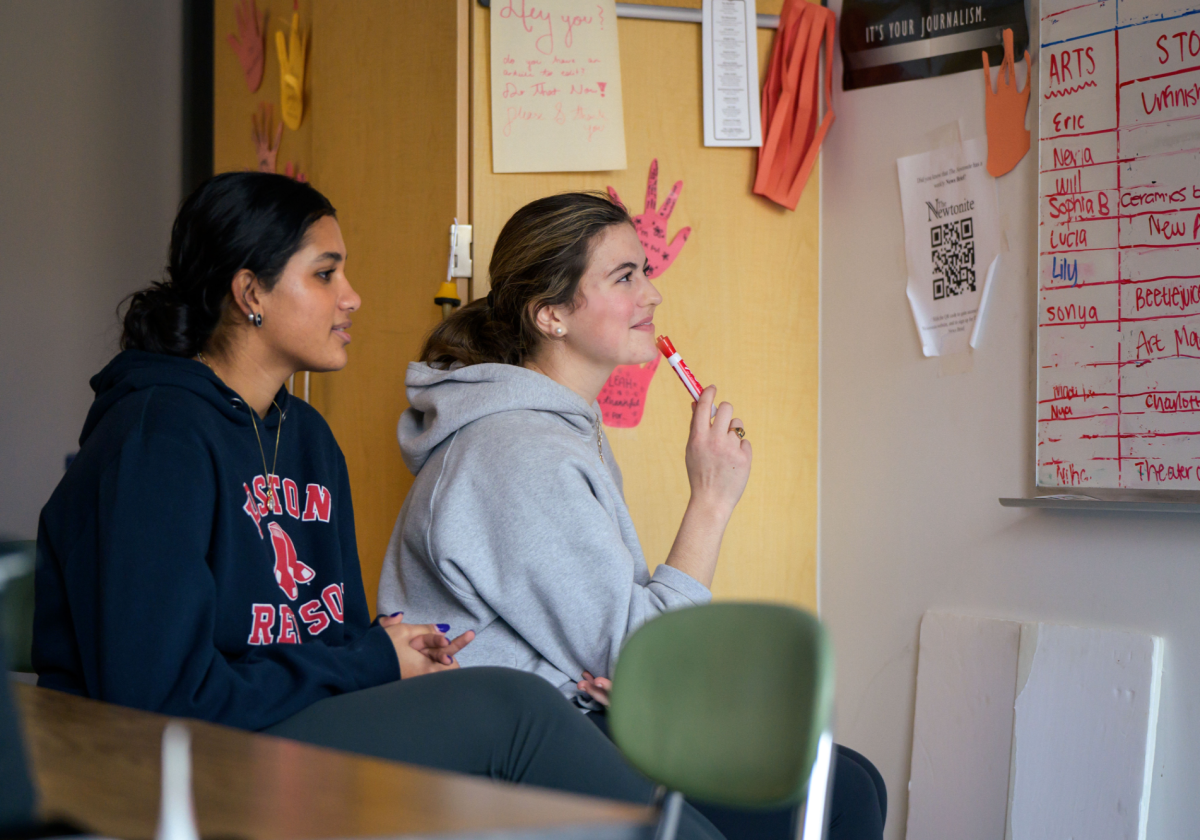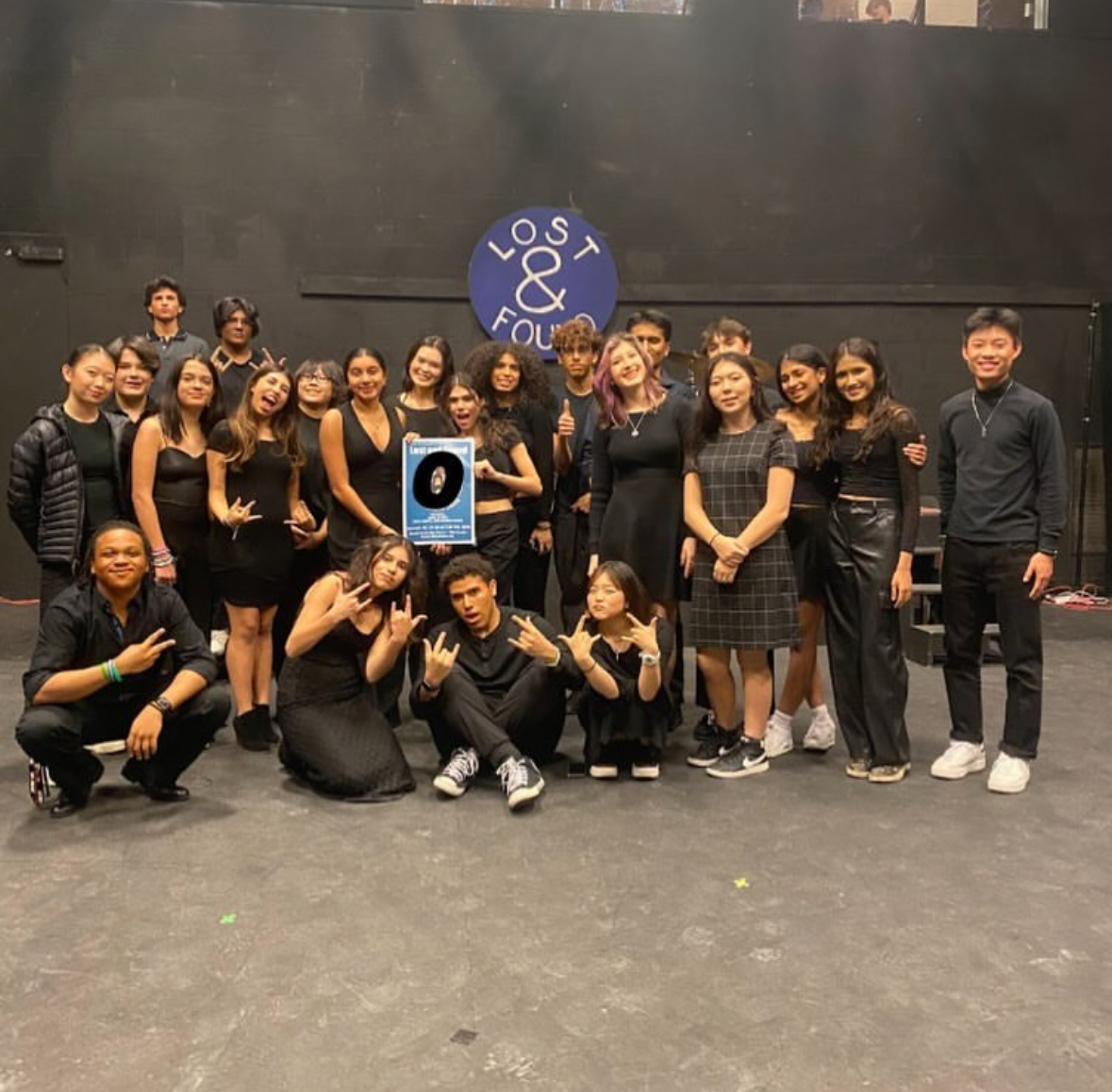A-block
by Laura Schmidt-Hong
Seniors Maddy Sherbet, Laurel Stanley, and junior Clare Donohoe spoke about eating disorders and diet addiction as part of Body Confidence Day last Wednesday during A-block in the Little Theatre.
Senior Megan Fieleke began by introducing Sherbet, Stanley, and Donohoe, saying, “We hope this day will help you develop a healthier view of you and your body.”
Sherbet opened the presentation by describing the various types of eating disorders, the role the media plays in causing them, and other influences which can induce them.
She said eating disorders “are often used to voice an internal struggle,” describing them as unhealthy “coping methods” some turn to in an effort to manage stress.
While anorexia nervosa and bulimia are the eating disorders which are the most well-known, Sherbet noted, “there’s actually a very wide range of eating disorders,” which consequently makes identifying them difficult. Of these disorders, Sherbet described anorexia nervosa, binge eating disorder, body dysmorphia, bulimia, orthorexia, pica, and rumination disorder.
She added, “There are feelings of being out of control for all of these,” and “eating disorders really aren’t a choice.”
Sherbet moved on to discuss how social media can create unrealistic beauty standards and can negatively impact body image. She pointed to Instagram fitness accounts, the use of polarizing language online, and edited photos as examples of the role the media plays in exacerbating unhealthy habits.
“It creates this rhetoric of, ‘If I eat this, I am bad,” which leads to a “vicious cycle” of equating self-worth with one’s diet, she explained. “This notion that we have to restrict ourselves isn’t healthy thinking.”
Sherbet also noted that comments from friends and family, such as using eating disorders as a descriptor for someone’s body shape or weight—for example, offhandedly describing someone as “anorexic”—can influence others and eventually lead to eating disorders.
Next, Stanley spoke about eating disorders specifically among men, saying, “it’s not really talked about,” and, while eating disorders are often viewed as a “women’s problem,” they are in fact “completely gender neutral.”
“People often don’t think men can have disordered eating,” she said, adding that “every image of men you see in the media is of one body type: muscular and toned.” These images can lead to disorders such as muscle dysmorphia, considered a subtype of anorexia nervosa, in which those affected “exercise and lift weights excessively,” said Stanley.
Donohoe then discussed the roles of dieting pills and calorie counting apps in shaping body image. She explained that diet pills reduce one’s appetite or increase the number of calories burned in order to increase weight loss, but side effects often include breathing problems, heart palpitations, and digestive problems, and the results from the pills are only temporary.
As for calorie-counting apps, she said, “People can get fixated on every single thing they put in their body,” which can lead to “obsessive thinking and anxiety about their health.” Similarly, tracking devices “can take the joy out of the little things” and “aren’t forgiving for specific circumstances and genetics,” she noted.
“You have to trust your body and trust yourself,” Donohoe explained.
B-block
By Amy Morrill
Senior Megan Fieleke and juniors Anna Fischer and Daisy Hutter spoke about common myths surrounding weight and health during B-Block on Body Confidence Day last Wednesday.
Hutter began the presentation by describing the myth that people have to both look and act a certain way and weigh a certain amount to be healthy. She explained that health is not completely aligned with weight but is instead more about lifestyle.
She went on to debunk the myth that all “fat” people lead unhealthy lifestyles. As part of her presentation, she showed a video of Jessamyn Stanley, a yoga instructor who challenges the stereotype that only skinny white people can do yoga.
In the video, which depicted Stanley doing a variety of challenging yoga moves, she said, “If you’re a fat girl and do any type of exercise, they want you to cover up your body. For me to say ‘f— that,’ that’s something that could change lives.”
Later, Fischer projected pictures of food such as a fruit basket, kale, chocolate cake, and pizza, and then asked the audience to raise their hands if they thought the food was “inherently bad” or “inherently good.” Although the majority of the audience raised their hands to condemn chocolate cake as a “bad” food, Fischer explained that that is not necessarily the case.
“Balance is key,” she said. “All foods provide different nutrients that serve different purposes. Calling food good or bad puts moral judgement on food choice.”
She expanded on her idea with the example of eating an extra cookie, saying that everyone does it sometimes.
“Society gives us an image that if we eat a cookie we’re a terrible person, will die alone, and are fat and terrible,” she said. “That’s not a thing.”
According to Fischer, another common myth is that one’s body mass index (BMI) is directly correlated with health. However, she explained that it is used by doctors to see trends but doesn’t take into account body composition.
“For people who aren’t doctors, instead of focusing on BMI, focus on how you feel about your body,” she said, adding, “Talk to a doctor if you have concerns.”
After describing all of the myths, Fieleke showed a senior class survey asking what they appreciated about people other than their physical appearance. Answers included humor, ambition, and kindness.
Fieleke then explained positive, healthy tactics for nutrition, namely “mindful eating.” She described that cravings happen for a reason and that one should “eat when you feel hungry and until you feel satisfied.”
Next, they opened the presentation to anonymous questions from the audience, written on notecards and collected throughout the block.
One person asked, “How do I know if I’m unhealthy?” Fischer responded that it truly depends on how you feel.
“Health is what gets each person to the point where you feel energetic and able to do things,” she said. “If you have questions, ask a doctor because they are good at helping find the healthiest lifestyle.”
Rachel Benson, who works at Multi-Services Eating Disorder Association, concluded the presentation by saying, “Health is a widely used term that really means a very nuanced relationship between you and what you eat. Body confidence is about finding what works for you.”
D-block
by Hannah Liu
Zoe Jasper, a member of the body confidence club, and junior Joita Diecidue, who has cerebral palsy, discussed the overlap between ableism and body image for Body Confidence Day, on Wednesday, in the Little Theatre. Jasper explained that person-first language, neutral connotations, and increased representation of people with disabilities in the media can help to minimize “inspiration porn” which objectifies people with disabilities.
“Treat us like human beings. Forget the fact that I walk with crutches.” Diecidue added that she would rather label herself as a “human being” than someone with cerebral palsy.
Diecidue transferred from Brookline Public Schools to Newton North High School in part because the North athletic department accommodated to her needs. Basketball is “really important” and “a big part” of Diecidue’s life. Brookline was unwilling to assist Diecidue’s special needs.
Ableism is the discrimination of people with disabilities. According to Jasper, the media is exclusive of people with disabilities because it usually only features people with fully able bodies.
Jasper explained the concept of “person-first language,” it is when language is structured to put a person’s humanity before their disability. Jasper explained that it is preferable to labeling someone as “disabled.”
Neutral connotation is another language detail that is inclusive toward people with disabilities. According to Jasper, it is when people with disabilities are not treated as victims of their disability.
To demonstrate the importance of representation of people with disabilities in pop culture, the presentation included a video of a girl with a disabled leg who was ecstatic that she had a doll like her own body.
On a positive note, Jasper introduced a fashion line, “Runway of Dreams,” that is breaking into the fashion industry by creating adaptive clothing, which is clothing designed for people with disabilities. Additionally, Tommy Hilfiger, is the first mainstream fashion line to introduce an adaptive clothing line.
“I see myself, my body, represented in the media all the time because I have that privilege, but if you have a disability, you so rarely get that.” Jasper continues, “It’s really hard to develop a healthy self image, to feel valid, to feel beautiful and to feel like you have the right to take up space.”
E-block
by Samantha Fredberg
A panel of transgender community members discussed body dysphoria and shared personal experiences during E-block of Body Confidence Day.
Junior Maya Gomberg moderated the panel, which was comprised of North alumnus Michael Greenspan, senior Seneca Niehaus, sophomore Achille Ricca, and former Newton Public School teacher Jen Stephens.
The panelists discussed their body dysphoria—unease or unhappiness with their bodies— as transgender individuals.
“Prior to puberty I did not have body dysphoria, only social dysphoria,” Greenspan said. “Once I hit puberty my body became a very big issue for me.”
As a gender non-binary individual, Niehaus explained their discomfort with their body. “I tried being male, but I thought, ‘this is not right.’ I flip-flopped between hypermasculine and hyperfeminine until someone said ‘you don’t have to be either,’” they said.
When going through a gender transition, body dysphoria can also lead to isolation, according to Greenspan. “When I was younger I was trying to disappear at all times,” he said. “I really just wanted to be left alone.”
According to Ricca, it is hard to feel comfortable with your body when it does not match your mental state. “A lot of the time in public, I’ll hear ‘ma’am’ or ‘ms.,’ and that is just crushing. I try hard, I bind, I pack, I wear loose clothing, and then it feels like it doesn’t really work.” he said.
The panelists closed the discussion by sharing the experiences in which they have felt the most confident. For Greenspan, this has to do with his decision to begin swimming again. He explained that he refused to swim for most of his childhood because he did not feel comfortable in his bathing suit. “In the past year I have gotten back into swimming,” he said. “Now I feel comfortable enough in my swim trunks, and even though I have scars on my chest from surgery, I just don’t care.”
F-block
by Maya Waldman
Senior Alli Salwen and junior Abby Strayer discussed plus-sized fashion during their presentation at Body Confidence Day last Wednesday F-block in the Little Theater.
The presentation included a slideshow about plus size fashion, an analysis of several media sources, and responses to questions from the crowd.
“Plus size does not mean unhealthy,” said Salwen. “It’s really important to make that distinction.”
The presenters began by examining three general body types: ectomorph; lean and long, endomorph; big with high body fat, and mesomorph; muscular and well-built. “Of course people don’t fit neatly into these categories,” said Salwen.
In these three body types, there are also many different body shapes, including pear, spoon, hourglass, and diamond, according to Strayer.
Part of the presentation was a discussion of the history of body shapes. “Being fat was considered beautiful during the Renaissance in Europe because it meant that you were wealthy,” said Strayer.
Marilyn Monroe popularized the hourglass shape in her time period, according to Salwen. She added that during different time periods, different body types are favored over others as the “beauty standard.”
The presentation included quotes from plus size blogger CeCe Olisa and plus size model Myla Dalbesio as well as a Buzzfeed video about plus size clothing.
The presenters also explored the ideal male body image and what plus size clothing looks like for men. “It’s not just women who have this standard— it’s everyone,” said Salwen.
“Just because an item of clothing fits you doesn’t mean it’s flattering,” said Strayer, as she discussed the limited options that many plus size people face while shopping for clothing.
When asked how they felt about stores that sell pieces of clothing in only one size, the presenters were weary. “One size never fits all,” said Salwen.
The presentation concluded with the plus size “segregation” that often occurs in stores. “In a perfect world, we wouldn’t have separate, segregated plus size sections,” said Strayer. “Maybe one day we will.”
Body Confidence Day speakers encourage self-acceptance
April 24, 2017
0
Donate to The Newtonite
More to Discover

















































